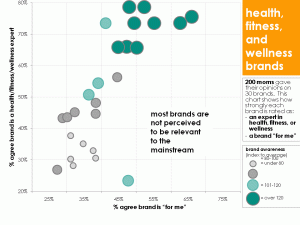when differentiation isn’t the answer
“Differentiate or die” is probably a familiar mantra to all; and there’s a well-established albeit less pithy corollary – don’t sell the category, sell your brand. After all, given the overcrowded nature of most categories, the hope of success for most brands rests on their ability to stand out from their numerous competitors. And promoting the category usually only benefits the market leader.
That’s why the most common marketing challenge is communicating a brand’s differentiation. But there are instances where differentiation is not the primary issue — and in many of these cases, it’s the relevance of the category itself which marketing must establish.
I’m thinking there are at least three business situations in which marketing should focus on increasing a brand’s relevance first, and differentiating the brand second.
seeking more mass appeal for niche brands
When a company aspires to broaden its appeal beyond a narrow target audience, the brand’s relevance to the broader audience must be established.
For example, many health, fitness, and wellness brands enjoy a strong and loyal core customer base. People who have a disciplined exercise regimen are likely to know and love brands of sport-specific apparel, fitness clubs, and nutritional supplements. So they’re likely to respond to communications intended to position a brand as an expert in its field or a particular aspect of the category.
But most brands in these categories aren’t even on the radar screens of the majority of U.S. adults who live primarily sedentary lives. In fact in some recent proprietary research I conducted among a general audience, many health/fitness/wellness brands performed strongly on perceived expertise in their category but were much weaker when it came to being a “brand for me” (see chart below.)
As such, marketing for these brands shouldn’t be about a brand’s superior performance on the things the narrow target audience cares about – e.g., unique product formulations, expert endorsements, etc. Instead marketing should be focused on explaining the benefits of the category and connecting those benefits to primary drivers of the mass market.
I recognize that not every niche brand wants to go mainstream – but those which are serious about growing exponentially will most likely have to. They can’t expect mass-market consumers to just “get” their brand, much less their category.
introducing “new to the world” innovations
Many innovations introduce new features, form factors, delivery mechanisms, etc. which capitalize on existing demand. When marketing these innovations, companies explain how the new product or service improves upon – and importantly, how it differs from — existing options.
However, new products and services which are truly “new to the world” have no such foundation of existing consumer relevance. Often these innovations are developments people could not have even imagined previously — completely new ways of doing, thinking, experiencing, even living.
Innovations in technology tend to fall into this category. When the integrated iPod/iTunes solution initially launched years ago, the marketing brief was simply to tell people what had become possible in music listening. The ability to seamlessly download songs and store thousands of them “in your pocket” was a compelling proposition in itself – messages about the uniqueness of Apple’s brand would have been superfluous.
Listening to music is a relatively universal consumer want/need and so, for Apple, the relevance of its solution was pretty easy to establish. Other innovations, however, are based on less salient drivers — so companies must generate perceptions of relevance by communicating a compelling vision of the category. People must see themselves in the story of the innovation before they will care and can appreciate what makes the particular brand unique.
addressing changed consumers’ needs
In some cases, a brand has lost appeal because people no longer perceive the category it trades in to be relevant. Perhaps consumer values have shifted – or their lifestyles have changed – or new technologies have rendered the category practically obsolete.
The viability of some retailers is being threatened in this way. The Internet has given people direct access to products they previously relied on retailers to make available to them – and in many cases, consumers can access even more products than they used to through retailers. So retailers which previously touted their unique or exclusive access to certain merchandise are finding such claims no longer true, nor differentiating.
The best way for retailers to combat this is not necessarily to try to regain the upper hand on access. Instead, retailers may need to re-establish the importance of the physical store in the shopping experience. By promoting the sights, sounds, smells, and tactile elements – especially the human contact – of the store shopping experience in general, companies can make shopping in retail stores more relevant to today’s experience-seeking consumers.
Ultimately relevance is accomplished by weaving your brand into the fabric of consumers’ everyday lives. Brands addressing the above business challenges shouldn’t take it for granted – are there others you can think of? Please let me know.
